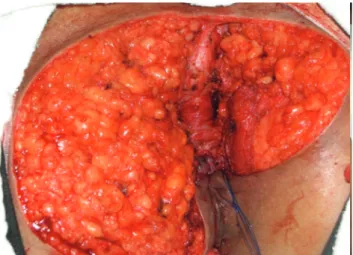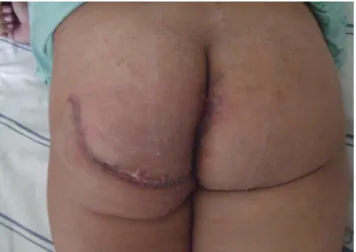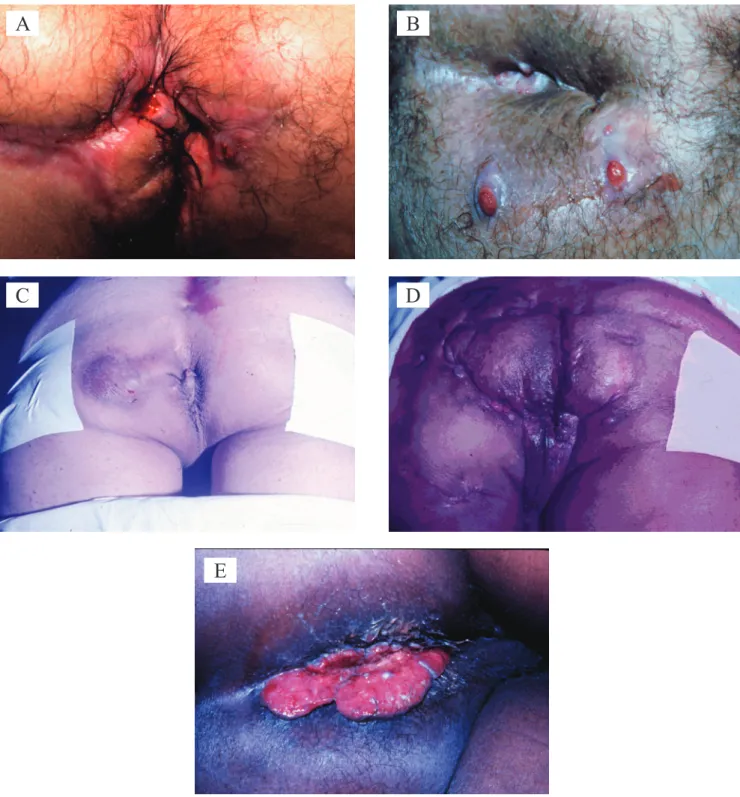Andrade MMA, Constantino JRM, Gomes DMBM, Faria FF, Oliveira RG, Ferreira RMRS, Cruz GMG. Hidradenitis suppurativa: literature review and case report. J Coloproctol,2012;32(2): 196-201.
ABSTRACT: Hidradenitis suppurativa (HS) is a chronic, recurrent and debilitating disease, affecting mainly women, especially in their sec-ond and third decades of life. Its most common incidence is in the axillary, inguinal, perianal and inframammary regions. Its complications include chronic istulizing processes, with involvement of important adjacent structures, such as the sacrum and coccyx, the anal sphincter, urethra and great-caliber vessels, such as the groin vessels. The proportions of some cases of HS requiring extensive surgical procedures at several moments and the application of laps and grafts, justify unusual cases reports, like this one. The authors present a case of extensive involvement of the perianal and gluteal regions, which required extended resection with lap in the irst approach and istulectomy in a second surgical moment, with good result for the patient.
Keywords: hidradenitis suppurativa; buttocks; surgical laps.
RESUMO: A hidradenite supurativa (HS) é uma doença crônica, recorrente e debilitante, que afeta principalmente mulheres, sobretudo na segunda e terceira décadas de vida. Incide mais nas regiões axilar, inguinal, perianal e inframamária. Dentre suas complicações crônicas, são descritos processos istulizantes com comprometimento de estruturas importantes, como o sacro e o cóccix, aparelho esincteriano, uretra e vasos calibrosos, como os inguinais. As proporções de alguns casos de HS, exigindo intervenções alargadas, em vários tempos e com aplicação de retalhos e enxertos justiicam relatos de casos que fogem da rotina, como o atual. Os autores apresentam um caso de comprometimento extenso da região glútea e perianal, que exigiu ressecção alargada com retalho e istulectomia em um segundo tempo cirúrgico, com bom resultado para a paciente.
Palavras-chave: hidradenite supurativa; nádegas; retalhos cirúrgicos.
Hidradenitis suppurativa: literature review and case report
Mônica Mourthé de Alvim Andrade1, José Roberto Monteiro Constantino2, Daniel Martins Barbosa M. Gomes1,
Flávia Fontes Faria1, Rodrigo Guimarães Oliveira1, Renata Magali R. Silluzio Ferreira2, Geraldo Magela Gomes da Cruz3
1Attending postgraduate program in Coloproctology at Faculdade de Ciências Médicas de Minas Gerais (FCMMG) – Belo
Horizonte (MG), Brazil. 2Assistants of the Group of Coloproctology (GCP), Santa Casa de Belo Horizonte (SCBH) – Belo
Horizonte (MG), Brazil. 3Coordinator of the GCP-SCBH – Belo Horizonte (MG), Brazil.
Study carried out at the Santa Casa de Misericórdia de Belo Horizonte – Belo Horizonte (MG), Brazil. Financing source: none.
Conlict of interest: nothing to declare.
INTRODUCTION
Hidradenitis suppurativa (HS) is a chronic, recurrent and debilitating disease, affecting main-ly women, especialmain-ly in their second and third de-cades of life1-8. Its most common incidence is in the
axillary, inguinal, perianal and inframammary re-gions3,9,7. Its cause has been attributed to apocrine
duct occlusion caused by keratin plugs, involv -ing some trigger-ing factors – friction of adipose tissue, sudoresis, heat, stress, tight clothes – and some facilitating factors – genetic and hormonal
factors1,2,4-6,8,10,11. Its chronic complications include
chronic istulizing processes, with involvement of important adjacent structures, such as the sacrum
and coccyx, the anal sphincter, urethra and great-caliber vessels, such as the groin vessels10. The
pro-portions of some cases of HS requiring extensive surgical procedures at several moments and the
ap-plication of laps and grafts, justify unusual cases reports, like this one2.
Hidradenitis suppurativa: literature review and case report Mônica Mourthé de Alvim Andrade et al. J Coloproctol
April/June, 2012
Vol. 32 Nº 2
CASE DESCRIPTION
Clinical examination: MAMN, female, 45 years old, with three years of purulent secretion drainage in the gluteal and perianal regions.
Proctologic examination: at the inspection,
sever-al istulous oriices are observed, with psever-alpable cours
-es through the skin with purulent secretion drainage,
located in the gluteal and perianal regions (Figure 1). No anomalies were detected with rectal touch exami-nation and rectosigmoidoscopy.
Colonoscopy: performed until the terminal ile-um, without alterations.
Intestinal low: no alterations.
Blood exams: routine exams, as well as hepatic function tests, VHS and PCR, did not show alterations.
Diagnostic hypothesis: hidradenitis suppurativa.
Conduct: radical excision of skin and subcutane -ous tissue affected by the disease.
First surgery: a radical excision of affected skin
and subcutaneous tissue was performed using seton
of a perianal istula. The bleeding area reconstruc -tion was performed using rota-tion of subcutaneous
skin and muscular fascia laps (Figures 2 and 3A and B). The inal aspect of the surgery was according to expected patterns, with proper skin approximation
(Figure 4).
Histopathology examination (HPE): the specimen
HPE showed istulous courses in the subcutaneous tis -sue, suggesting hidradenitis suppurativa (Figure 5).
Second surgery: the approach to the istula chan
-neled by seton in the irst surgery was performed 40
days later, with excellent surgical result.
Patient control: the patient was examined two and four months after the second surgery, and at these
two moments, the inal aspect of the surgery was doc -umented (Figures 6 and 7).
LITERATURE
Other names
Hidradenitis Suppurativa, Hidrosadenitis Sup-purativa, Acne Inversa, Acne Conglobata, Verneuil’s Disease, Velpeau’s Disease1,3,12,13.
History
HS was first described by Velpeau (1839), who reported unusual processes related to the pe-culiar locations of axillary, mammary and perianal abscesses. For this reason, it was named “Vel-peau’s disease”. After some time, Velpeau was not included in the references, despite his classical study of 183913.
However, that was Verneuil, through his several
publications on the subject in the 1850’s, who most contributed to the knowledge of this disease, until then known as “Velpeau’s disease”. For this reason, “Ver -neuil’s disease” was also established, recognizing the importance of his publications12.
Figure 1. Panoramic view of hidradenitis suppurativa.
Figure 2. Panoramic view of the bleeding area of surgical resection and seton insertion to concomitantly approach
But the relation of HS with sweat glands was made only about 30 years after that, by Dubreuilh (1893), in his classical study of almost 120 years14.
Pollitzer, also in 1893, repeated the studies made
by Dubreuilh, and the irst case of HS was published
on around 40 years after Brunsting (1939).
General
HS is a chronic, recurrent and debilitating dis-ease, affecting mainly women, especially in their second and third decades of life2-8. Its most
com-mon incidence is in the axillary, inguinal, perianal and inframammary regions1,3,5,7,9. Its cause has been
attributed to apocrine duct occlusion caused by ker -atin plugs, involving some triggering factors – fric-tion of adipose tissue, sudoresis, heat, stress, tight clothes – and some facilitating factors – genetic and hormonal factors1,2,4-6,8,10,11.
Diagnosis
The diagnosis is eminently clinical, based on symptoms reported by the patient and signs ob-served by the physician. The initial symptoms include discomfort, pruritus, erythema and hy-perhidrosis in the affected area7. With the
dis-ease progress, the symptoms are more evident. The physical examination detects lesions in the form of multiple diffused abscesses, with chronic drainage in the form of multiple fistulas through
fistulous orifices of varied aspects. The skin and
subcutaneous tissue in the affected area become
Figure 3. Internal view (A) and external view (B) of the resected surgical specimen.
A
B
Figure 4. Panoramic view of the immediate result of the surgery, after using cutaneous laps.
Hidradenitis suppurativa: literature review and case report Mônica Mourthé de Alvim Andrade et al. J Coloproctol
April/June, 2012
Vol. 32 Nº 2
hardened, fixed and fibrotic, welding the dermis
and epidermis layers together, keeping them from
sliding apart4,7,8,11.
The clinical condition is characterized by long-term symptoms and signs that may reach 30 years of progress, with recurrent abscesses and fistulas, which, after the inflammatory phase, leave sequelae such as areas of fibroses, fistulous orifices and scarce purulent secretion1,4,10,11. When
the disease affects the perianal area, it rarely in-volves the anal sphincter8,10. The diagnosis, in the
chronic form of the disease, is clinical and easily performed, depending the coloproctologist’s expe-rience. In certain situations, a biopsy is required to confirm the diagnosis, such as in the atypical
cases of perianal Crohn’s disease, tuberculous ul-cer and carcinoma. The association with spinocel-lular carcinoma, in case of long-term progress, is very rare1,7,15,16.
The most important acute complication is
char-acterized by an inlammatory and later infectious process, affecting supericial and deep tissues with
cellulitis, abscesses and suppuration. Its chronic
complications result from istulas and the involve -ment of important structures, such as the sacrum and coccyx, the anal sphincter, urethra and great-caliber vessels, such as the groin vessels1,4.
Complementary exams are required in the
pres-ence of extensive suppurative areas, deep istulas
and involvement of noble structures. Bacteriosco-py and culture of secretions, radiography of the
sa-crum and coccyx, istulography and computed tomog -raphy of the pelvis can be performed.
The histopathology exam shows a cellular re-action into the lumen of apocrine sweat glands, with
distention by leukocytes and cellular iniltration of adjacent conjunctive tissue. In the macroscopic per -spective, the subcutaneous tissues have higher
densi-ty, skin purple discoloration and istulous oriices with
little purulent secretion8.
The secretion culture can isolate Streptococcus
milleri, Stasphylococcus aureus, anaerobic
Strepto-coccus and bacteroids7,8.
Differential diagnoses
The diseases that should be considered and ruled out as differential diagnoses include
(Fig-ure 8): Crohn’s disease (Fig(Fig-ure 8A), anorectal is
-tulas (Figure 8B), perianal is-tulas (Figure 8C),
cutaneous tuberculosis (Figure 8D), lymphogranu-loma venereum (Figure 8E), pilonidal cyst, as well as other rarer diseases, such as anthrax, epidermoid cyst (infected dermoid cyst), erysipelas, furuncle, granuloma inguinale, steatocystoma multiplex and actinomycosis5,7,8,15.
Associated conditions
The conditions that can be associated with hi-dradenitis suppurativa include: acanthosis nigricans, certain forms of arthritis, Crohn’s disease, Down’s syndrome, Graves’ disease, Hashimoto’s thyroiditis, herpes simplex, hyperandrogenism, irritable bowel
syndrome and Sjögren’s syndrome15.
Figure 6. Final panoramic view of the surgery two months after the surgical intervention.
Figure 8. Some morbid entities that should be considered as differential diagnoses of hidradenitis suppurativa: Crohn’s disease (A), multiple non-speciic anorectal istulas (B), non-speciic perianal istulas (C), cutaneous tuberculosis (D) and lymphogranuloma venereum (E).
Anogenital hidradenitis suppurativa
It affects more frequently the groin, involving the inguinal region, pubic region, internal face of the
perianal folds are frequently included; the istulas may
deeply dissect in the tissue, involving the musculature, fascia and bowel. In the perianal form, biopsies are
A
C
B
D
Hidradenitis suppurativa: literature review and case report Mônica Mourthé de Alvim Andrade et al. J Coloproctol
April/June, 2012
Vol. 32 Nº 2
Crohn’s disease. It rarely affects the anal canal, but if involved, it is never above the pectineal line7,8,15.
Treatment
Multiple treatment options are available, includ-ing antibioticotherapy, systemic retinoids, intralesion-al corticosteroids, hormonintralesion-al therapy, immunosup-pressors, radiotherapy, cryotherapy, local care of the lesion, laser therapy and surgical treatment. No iso-lated treatment was effective to the patients1-4,6-9,17.
The surgical approach still seems to be the ideal op-tion, and it may vary from simple incision and acute ab-scess drainage to radical excision of the whole tissue with apocrine glands. The radical excision of the whole
affect-ed tissue is the deinitive and gold-standard treatment, as
the recurrence rate is inversely proportional to the surgical radicality: the recurrence rate ranges from 100% in three months (isolated drainage) to 25% (cases of surgical radi-cality in 20 months after the radical excision)1-5,8,11.
CONCLUSION
The approach used in the treatment of hidrad-enitis suppurativa remains challenging to physi-cians and frustrating to patients. As the number of
randomized studies is insuficient, due to the lack
of long series of cases, comparing the several types of treatment, the best approach is based on the pa-tient’s clinical condition, results from prior nonsur-gical treatments and the physician’s experience. The radical excision is considered the gold standard, and it should be the treatment of choice, since it is well indicated. Leaving the surgical wound resulting from
enlarged resection of skin and subcutaneous tissue to heal at a second moment should not taken as the
best alternative, although this is an option in certain
patients; with lap rotations, when well indicated and
performed, as an important factor in the immediate quality of life of the patient.
REFERENCES
1. Jansen I, Altmeyer P, Piewig G. Acne inversa (alias hidradenitis suppurativa). J Eur Acad Dermatol Venereol 2001;15(6):532-40.
2. Mitchell KM, Beck DE. Hidradenitis suppurativa. Surg Clin North Am2002;82(6):1187-97.
3. Rompel R, Petres J. Long-term results of wide surgical excision in 106 patients with hidradenitis suppurativa. Dermatol Surg 2000;26(7):638-43.
4. Slade DE, Powell BW, Mortimer PS. Hidradenitis suppurativa: pathogenesis and management. Br J Plast Surg 2003;56(5):451-61.
5. Wiltz O, Schoetz DJ Jr, Murray JJ, Roberts PL, Coller JA, Veidenheimer MC. Perianal hidradenitis suppurativa. The Lahey Clinic experience. Dis Colon Rectum 1990;33:731-4. 6. Kraft JN, Searles GF. Hidradenitis suppurativa in 64 female
patients: retrospective study comparing oral antibiotics and antiandrogen therapy. J Cutan Med Surg 2007;11(4):125-31. 7. Sohail N, Spencer JP, Mather R. Chronic, draining perianal
sinuses. Am Fam Physician 2006;74(12):2089-90.
8. Mortimer PS, Lunniss PJ. Hidradenitis suppurativa. J R Soc Med 2000;93(8):420-2.
9. Mekkes JR, Bos JD. Long-term eficacy of a single course of inliximab in hidradenitis suppurativa. Br J Dermatol 2008;158(2):370-4.
10. Culp CE. Chronic hidradenitis suppurativa of the anal canal. A surgical skin disease. Dis Colon Rectum 1983;26(10):669-76.
11. Mandal A, Watson J. Experience with different treatment modules in hidradenitis suppurativa: a study of 106 cases. Surgeon2005;3(1):23-6.
12. Verneuil AS. Études sur les tumeurs de la peau: de quelque maladies des glandes sudoripares. Arch Gen Med 1854;94:693-9.
13. Velpeau A. Dictionnaire de Medicine. Un Repertoire des Sciences Medicales sons le Rapport. Theorique et Pratique. 2nd ed. Paris. France; 1839. 91 p.
14. Dubreuilh W. Des hidrosadénites suppurées disséminées Archives de médecine expérimentale et d’anatomie pathologique. 1er Janvier 1893;1.
15. Church JM, Fazio VW, Lavery IC, Oakley JR, Milsom JW. The differential diagnosis and comorbidity of hidradenitis suppurativa and perianal Crohn’s disease. Int J Colorectal Dis 1993;8(3):117-9.
16. Rosenzweig LB, Brett AS, Lefaivre JF, Vandersteenhoven JJ. Hidradenitis suppurativa complicated by squamous cell carcinoma and paraneoplastic neuropathy. Am J Med Sci 2005;329(3):150-2.
17. Bong JL, Shalders K, Saihan E. Treatment of persistent painful nodules of hidradenitis suppurativa with cryotherapy. Clin Exp Dermatol 2003;28(3):241-4.
Correspondence to:
Dra. Mônica Mourthé de Alvim Andrade



